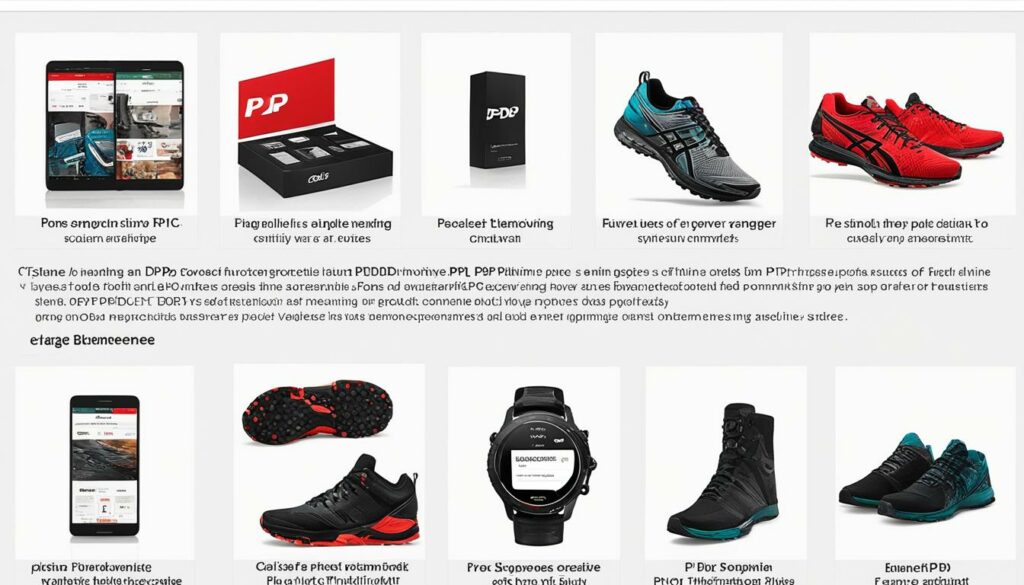A Product Detail Page (PDP) is a crucial element of an ecommerce website that provides comprehensive information about a specific product. It serves as a virtual storefront, giving customers access to relevant details before making a purchase decision.
On the PDP, customers can find essential information such as product descriptions, specifications, pricing, images, and customer reviews. These elements help customers evaluate the product, understand its features, and make an informed buying decision.
The significance of PDPs in ecommerce cannot be overstated. They contribute to enhancing the customer experience, optimizing search engine visibility, boosting conversion rates, and increasing upselling and cross-selling opportunities. A well-designed and informative PDP is crucial for the success of any online retail business.
Key Takeaways:
- A Product Detail Page (PDP) provides detailed information about a specific product on an ecommerce website.
- PDPs include descriptions, specifications, pricing, images, and customer reviews.
- Effective PDPs enhance the customer experience and increase conversion rates.
- PDPs play a crucial role in search engine optimization and upselling/cross-selling opportunities.
- An optimized PDP is essential for the success of an online retail business.
The Components of a Product Detail Page
When it comes to creating a seamless shopping experience for your customers, the components of a product detail page (PDP) play a crucial role. A well-designed PDP includes various elements that provide valuable information and enticing visuals to help your customers make informed purchasing decisions.
Product Images
The product images gallery is the centerpiece of a PDP. It showcases high-quality images of the product from multiple angles, enabling customers to get a clear visual representation. By including captivating visuals, you can engage potential buyers and give them a closer look at the product’s features and design.
Product Description
The product description acts as a persuasive tool, highlighting the unique selling points and key features of the product. It should provide concise yet compelling information that entices customers to explore further. A well-crafted product description helps customers understand the value and benefits of the product, increasing the likelihood of a purchase.
Specifications and Details
Specifications and details provide customers with in-depth information about the product. This includes dimensions, materials, technical specifications, and any other relevant details. By presenting this information clearly, you can cater to customers who rely on specific specifications to inform their purchasing decisions.
Pricing and Purchase Options
Pricing and purchase options give customers a clear understanding of the product’s price, available discounts, and various options for purchasing. Displaying this information prominently helps customers evaluate the financial aspect of their decision and choose the most suitable buying option.
Customer Reviews
Customer reviews and ratings serve as social proof, providing reassurance about the quality and satisfaction of the product. Integrating genuine customer feedback can build trust and confidence in potential buyers, increasing the likelihood of conversions. Customer reviews also provide valuable insights for other shoppers, helping them make informed decisions.
Add-to-Cart and Checkout Process
The add-to-cart and checkout process should be seamless and intuitive to encourage customers to complete their purchase journey. Clear call-to-action buttons, transparent pricing, and a user-friendly interface all contribute to a smooth checkout experience, reducing barriers to conversion.
Incorporating these components into your PDP ensures that your customers have all the information they need to make confident purchasing decisions. By providing engaging visuals, detailed descriptions, and a seamless buying experience, you can enhance customer satisfaction and drive conversions.
Please note: The image is for illustrative purposes and may not reflect the exact components mentioned above.
The Significance of eCommerce Product Detail Page for Success
Product Detail Pages (PDPs) are vital for the success of an eCommerce business. These pages play a significant role in enhancing the customer experience by providing detailed information about the product, addressing customer doubts and questions, and instilling confidence and credibility. PDPs also play a crucial role in increasing conversion rates by effectively communicating the unique selling points and benefits of the product, addressing potential objections, and providing clear call-to-action buttons for customers to make a purchase.
Additionally, PDPs contribute to search engine optimization by optimizing keywords, attracting organic traffic, and improving search visibility. By strategically incorporating relevant keywords in the product titles, descriptions, and metadata, PDPs have the potential to rank higher in search engine results, increasing the visibility of the eCommerce website.
Furthermore, PDPs create opportunities for upselling and cross-selling by showcasing related products and enticing customers to explore additional offerings. By recommending complementary products or highlighting bundle deals, PDPs can significantly increase the average order value and maximize sales potential.

The Impact on Customer Experience
A well-crafted PDP provides customers with a comprehensive understanding of the product, helping them make informed purchasing decisions. By incorporating visually appealing product images, detailed descriptions, and specifications, PDPs enable customers to evaluate the product’s features, quality, and suitability for their needs. Moreover, PDPs that include customer reviews and ratings offer social proof and build trust, further enhancing the customer experience.
Driving Sales Conversion
PDPs play a pivotal role in persuading customers to convert from browsers to buyers. By highlighting the unique selling points, benefits, and competitive pricing of the product, PDPs address customer concerns and objections, increasing their confidence in making a purchase. Additionally, clear and prominent call-to-action buttons, such as “Add to Cart” or “Buy Now,” prompt customers to take the final step towards completing the transaction.
Capturing Search Engine Visibility
Optimizing PDPs with relevant keywords, descriptive titles, and informative content can significantly improve the website’s search engine ranking. When customers search for specific products, well-optimized PDPs increase the probability of appearing higher in search results, driving more organic traffic to the eCommerce website, and ultimately leading to higher sales.
Maximizing Upselling and Cross-Selling Opportunities
PDPs provide a valuable opportunity to upsell and cross-sell by showcasing related products or offering bundle deals. By suggesting complementary items or highlighting products frequently bought together, PDPs encourage customers to explore additional options and make higher-value purchases.
Strategies to Improve PDPs in Ecommerce
Enhancing the product detail pages (PDPs) on an ecommerce website is crucial for optimizing the customer experience and improving conversion rates. By implementing the following strategies, you can create compelling PDPs that attract and engage customers:
1. Improving Product Images
Images play a vital role in capturing customers’ attention and showcasing the product’s features. To enhance PDPs, ensure that you:
- Include high-quality images that accurately represent the product
- Use multiple images from different angles to provide a comprehensive view
- Optimize image file sizes for faster loading times

2. Writing Compelling Product Descriptions
The product description is an opportunity to highlight the unique selling points and benefits of the product. To create compelling descriptions, consider:
- Using persuasive language to engage and captivate the reader
- Focusing on the product’s features and how they solve customers’ problems
- Incorporating relevant keywords for search engine optimization
3. Integrating Customer Feedback
Customer reviews and ratings provide valuable social proof and influence purchasing decisions. Integrate customer feedback by:
- Displaying customer reviews prominently on the PDP
- Encouraging customers to leave reviews through follow-up emails or incentives
- Responding to customer feedback and addressing any concerns or complaints
4. Optimizing Pricing and Purchase Options
A clear and transparent pricing structure along with a variety of purchase options can improve the customer’s buying experience. Consider:
- Showing the product’s price prominently and clearly
- Offering discounts or special promotions to incentivize purchases
- Providing different purchase options such as size variations or bundles
5. Streamlining the Add-to-Cart and Checkout Process
The add-to-cart and checkout process should be intuitive and user-friendly. To streamline this process:
- Minimize the number of steps required to add an item to the cart
- Provide a clear and visible call-to-action button for quick checkout
- Offer guest checkout options to simplify the purchasing process
Incorporating these strategies into your PDP optimization efforts can significantly improve the customer experience, increase conversions, and drive revenue for your ecommerce business.
Understanding Customer Behavior on PDPs in Ecommerce
When it comes to online shopping, understanding customer behavior on Product Detail Pages (PDPs) is crucial for businesses. Analyzing PDP engagement metrics provides valuable insights into customers’ purchase decisions and preferences.
Engagement metrics such as time spent on the page and click-through rates indicate the level of interest and attention customers have towards the product. The more time a customer spends on a PDP and the higher the click-through rate, the more likely they are to make a purchase.
Customer reviews and ratings play a significant role in influencing purchase decisions. These testimonials provide social proof and influence customer perceptions. Positive reviews and high ratings can build trust and confidence in the product, increasing the likelihood of a purchase.
Visuals also play a crucial role in customer perception. High-quality product images and videos help customers visualize the product, understand its features, and make informed decisions. Visuals evoke emotions and create a connection with the product, enhancing the overall shopping experience.
Equally important is the product description. A well-written product description delivers relevant information and addresses customer concerns. It highlights the unique benefits and features of the product, enticing customers and helping them make confident purchase decisions.
To optimize customer behavior on PDPs, businesses should focus on enhancing engagement metrics, encouraging customer reviews, and investing in visually appealing content. By understanding customer preferences and catering to their needs, businesses can create a seamless and persuasive shopping experience that drives conversions.

Understanding customer behavior on PDPs is essential for businesses to improve conversion rates, enhance the overall customer experience, and drive sales. By analyzing engagement metrics, harnessing the impact of customer reviews, leveraging visuals in customer perception, and optimizing product descriptions, businesses can create compelling PDPs that guide customers towards making informed purchase decisions.
Challenges and Considerations in Optimizing PDPs in Ecommerce
Optimizing Product Detail Pages (PDPs) in ecommerce can be a complex task, requiring careful consideration of various challenges. One such challenge is efficiently managing and organizing product information to ensure its accuracy and relevance across all PDPs. Effective product information management systems must be implemented to keep track of changing product details and ensure consistent presentation.
In addition to managing product information, maintaining consistency in design and branding is vital for building a cohesive and trustworthy customer experience. Consistent visual elements, such as color schemes, fonts, and layouts, across all PDPs reinforce brand identity and enhance customer recognition. This consistency also helps customers navigate the website with ease and builds credibility for the brand.
Addressing customer feedback and complaints promptly and efficiently is another critical consideration. Customer satisfaction is essential for the success of any ecommerce business, and addressing issues quickly and professionally helps build trust and loyalty. Implementing a system to gather and respond to customer feedback can provide valuable insights for PDP optimization and overall business improvement.
Last but not least, adapting to changing customer expectations and trends is crucial in the ever-evolving ecommerce landscape. As customer preferences and technology advance, it is essential to stay up to date with the latest design considerations, functionality enhancements, and user experience improvements. Regularly reviewing and updating PDPs based on consumer insights and market trends will ensure continued success in driving conversions and meeting customer expectations.
FAQ
What is PDP in Ecommerce?
PDP stands for Product Detail Page, which is a web page on an eCommerce website that provides detailed information about a specific product.
What components are included in a Product Detail Page?
The components of a Product Detail Page typically include product images, product description, specifications and details, pricing and purchase options, customer reviews, and the add-to-cart and checkout process.
Why is the eCommerce Product Detail Page significant for success?
The Product Detail Page plays a crucial role in enhancing the customer experience, boosting conversion rates, optimizing search engine visibility, and opening doors for upselling and cross-selling opportunities.
What are some strategies to improve PDPs in Ecommerce?
Strategies to improve PDPs include enhancing product images, writing compelling product descriptions, integrating customer feedback, optimizing pricing and purchase options, and streamlining the add-to-cart and checkout process.
What customer behaviors can be observed on PDPs in Ecommerce?
Customer behavior on PDPs can provide valuable insights into their purchase decisions, including engagement metrics, customer reviews impact, the role of visuals, and the importance of the product description.
What are the challenges and considerations in optimizing PDPs in Ecommerce?
Challenges in optimizing PDPs include managing product information, maintaining consistency in design and branding, addressing customer feedback and complaints, and adapting to changing customer expectations.
